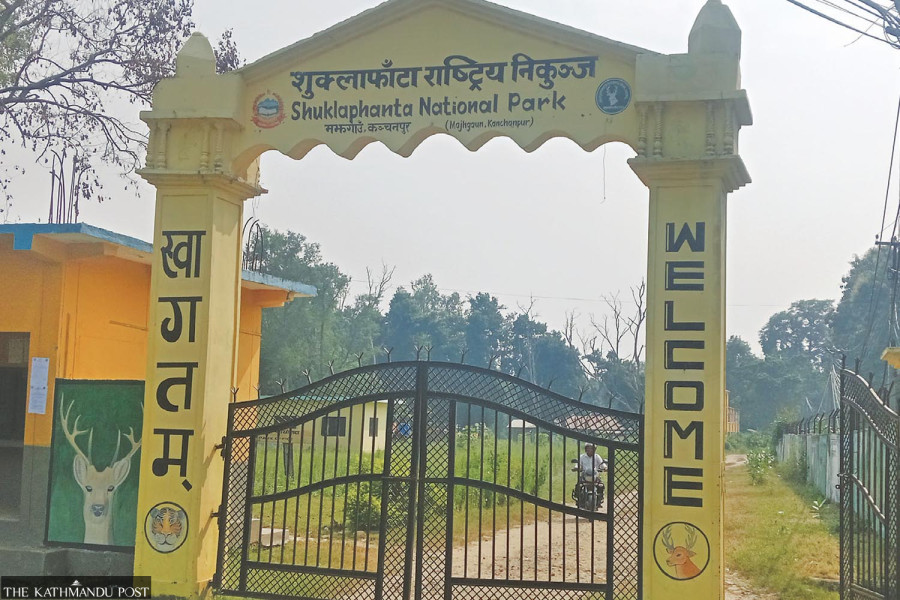Sudurpaschim Province
It’s tourist season, but Shuklaphanta National Park remains closed for visitors
Annual rainy season closure, compounded by flood damage, hurting revenue and frustrates visitors.
Bhawani Bhatta
Kshitij Sharma, who came to his parental home in Dhangadhi of Kailali district for Dashain celebration, planned to explore Shuklaphanta National Park in neighbouring Kanchanpur district during the festival vacation. He reached the national park’s entry gate in Majhgaun along with his three friends on Wednesday. But his plan to visit Shuklaphanta did not materialise as the national park that remained closed during the rainy season is yet to reopen for visitors.
“We reached the entry gate in the morning, but the park is still closed for the visitors. We returned from the park and visited Mahendranagar, the district headquarters of Kanchanpur, before heading back to Dhangadhi,” said Sharma, a software engineer at a Kathmandu-based insurance company.
Upon hearing that Shuklaphanta is home of swamp deer, tigers, rhinos, and several other species of flora and fauna, Sharma made a plan to visit the country’s second youngest national park for the first time. “My plan has been deferred once again,” he said.
Shuklaphanta National Park is composed of surreal landscapes—expansive grasslands vie for dominance with dense forests and tropical wetlands. A rangale of swamp deer, a streak of tigers, a flight of butterflies and birds—all tread the same spaces. Despite being rich in biodiversity and natural beauty, Shuklaphanta fails to attract visitors, mainly due to lackadaisical response of the park authorities.
Domestic tourism has been increasingly popular in the country lately. Many people, whether abroad or living in other parts of the nation, return home during Dashain, the biggest Hindu festival that normally falls in the month of October—sometimes it is pushed to November as the festival is based on the lunar calendar. The returnees make plans to visit the tourist destinations during their festival vacation.
October-November is the main tourist season in Nepal. Many tourists, both domestic and foreign, prefer to visit the tourist destinations in this season. Shuklaphanta National Park could be a major tourist destination during the festive season, but the park is still closed to visitors.
“Four or five groups called me during Dashain for jeep safaris in Shuklaphanta. People keep on inquiring about visits but I cannot give them a definitive answer on when the park will reopen,” said Parashuram Rana, a nature guide. According to him, he used to save around Rs50,000 through jeep safari in Shuklaphanta National Park during the Dashain-Tihar season in the past.
The national park fails to collect revenue owing to the delay in reopening for visitors during the tourist season. The park administration closed the park entry for the visitors with the beginning of the rainy season from July 1.
According to Manoj Air, conservation officer at Shuklaphanta National Park, the park administration is unable to open the park for visitors as the floods in the second week of July damaged safari tracks and bridges. “Around a dozen and a half wooden bridges were swept away by the floods. Efforts are ongoing to reopen the single-lane track for safaris. It takes time as well as a large amount of money to resume a two-lane safari track,” said Air. According to him, the safari track from Majhgaun to Shuklaphanta grassland through Ranital will be reopened within a week. “Safari from Majhgaun to Shuklaphanta grassland through Barkaula is not immediately possible as the track was badly damaged by the flood,” he added.
Established as a wildlife reserve in 1976 and declared a national park in 2017, Shuklaphanta is located in the southwestern corner of Nepal in the Sudurpaschim Province. As per the latest count, the national park is home to more than 2,300 swamp deer and 44 tigers. After its expansion on the eastern side, the Shuklaphanta National Park now spreads across 305 sq km.
The park lies close to the Indian border and thus is located strategically close to popular Indian national parks like the Dudhwa and Jim Corbett national parks. Shuklaphanta is also part of the Tarai Arc Landscape, which encompasses five million hectares of protected land in both India and Nepal.
Despite this proximity to the Indian border and its teeming wildlife, the park hosts comparatively fewer visitors. Only 3,067 tourists including 250 foreign tourists visited Shuklaphanta National Park in the last fiscal year of 2023-24. The number of visitors was only 2,729 in the fiscal year of 2022-23.




 22.65°C Kathmandu
22.65°C Kathmandu















